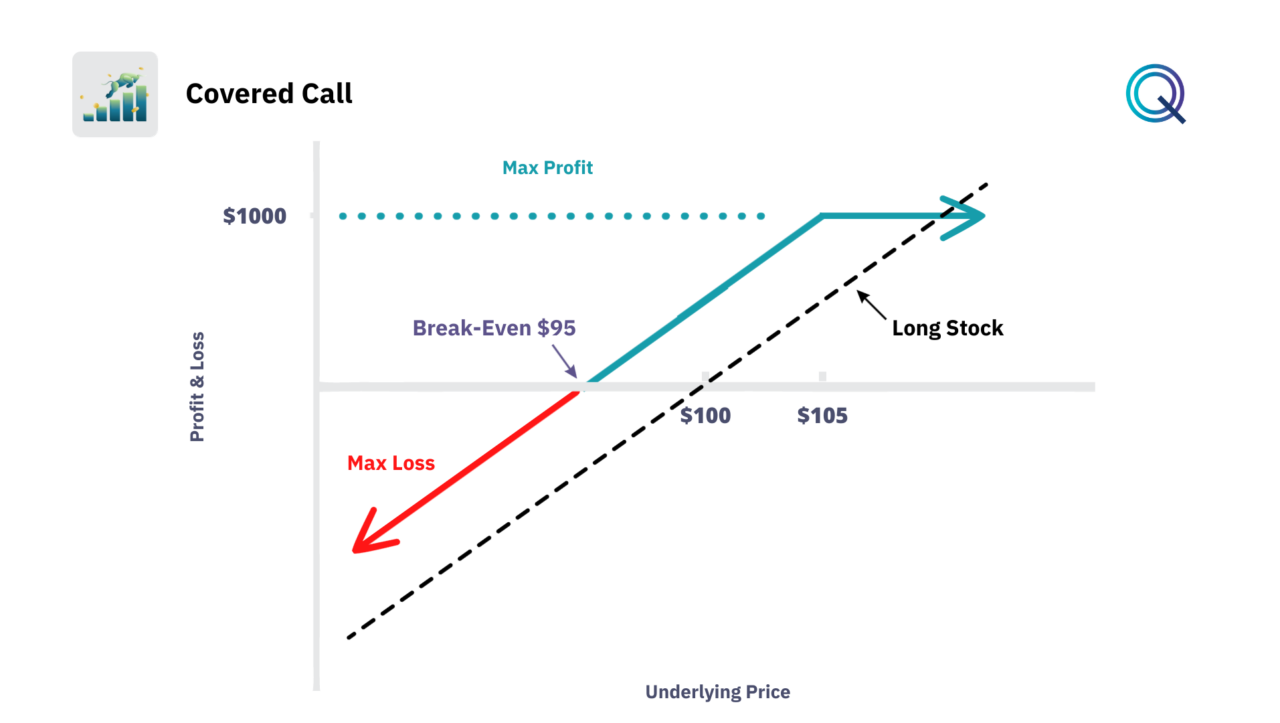Covered Call

Another Hedging Strategy is the Covered Call.
Often we own shares in our portfolio that are not performing and are moving sideways without generating profits. The question that every investor asks themselves is the following: “Is it possible to obtain an income from the underlying asset held in the portfolio?
Through Income strategies, we have the possibility of generating returns even when the market is moving sideways. In this article, we look at one of the most used strategies by investors: the Covered Call Strategy.
What is the Covered Call Strategy?
The Covered Call strategy involves selling Call options on the underlying asset that is already owned in the portfolio (it is called “covered” because it is covered by the underlying asset), thus generating a constant income.
- When you sell a Call, you are obligated to deliver the underlying asset if it reaches a certain price (strike price) within a certain expiration date, receiving a premium in return.
- If we do not own the underlying asset, we must purchase it at the market price on the option assignment day. Selling call options without owning the underlying exposes us to unlimited risks.
- Selling Naked call options is strongly discouraged as it exposes us to excessive risks.

Advantages of the Covered Call Strategy
- The Covered Call Strategy has the advantage of being a conservative strategy from bullish to neutral, as it is expected that the price of the underlying will remain stable or rise moderately.
- A sideways market is well-suited to this strategy, which allows maximizing the profit of shares held in the portfolio. For this strategy, it is advisable to choose slowly and steadily growing stocks that have performed well in the past and can be prudently maintained in the portfolio even if a market reversal occurs.
- The call seller, being the owner of the underlying shares, also has the right to collect the dividend if distributed during the option’s duration.
- Another advantage of using the Covered Call is the reduction of losses due to a possible drop in the price of the underlying. Thanks to the premium that we regularly collect from the sale of the Call option, we can limit potential losses on the downside.
- If you plan to own a stock for a long period, periodically selling Covered Calls can potentially improve returns.
Disadvantages of the Covered Call Strategy
- Among the disadvantages is only the possible loss of future profits in case the price of the underlying continues to rise and the buyer of the option decides to exercise the contract.
- Unlike the sale of Naked Call Options, without owning the underlying, where the risk is potentially infinite, with the Covered Call, we already own the shares.
- If the price of the underlying grows above the strike price at expiration or within the expiration, the option Buyer may exercise the contract and purchase the shares at the strike price.
- In this case, we will sell the underlying at the strike price. We have no risks in this sense, but if the price of the underlying continues to rise, we will lose the potential gain from the growth of the share price. We can in any case repurchase the underlying at any time after being called by the option buyer.
Factors to consider when using the Covered Call Strategy
There are a few factors we should consider:
- Rolling. If the stock’s price is approaching the strike price and the investor wishes to keep the stock, they can ‘roll’ the call option to a higher strike and/or a later expiration. This involves buying back the existing call and selling another with a higher strike or a later expiration date.
- Dividends. An investor can time the sale of covered calls with the ex-dividend date of the stock to potentially enhance returns through dividend payments in addition to the option premiums.
- Selection of Strike Price. The choice of strike price is key in a Covered Call strategy. A strike too close to the current price might result in the shares being called away more frequently, while a strike too far might result in lower premiums that do not justify the strategy.
- Earnings Reports. An investor might avoid selling covered calls over an earnings announcement to prevent capping potential gains if the stock price jumps or might use it as a strategy to generate higher premiums due to increased volatility.
- Opportunity Cost. While the premium received provides immediate income, there is an opportunity cost if the stock price rises well above the strike price and the shares are called away.
- Downside Protection. The premium received from selling the call option provides limited downside protection. It does not prevent loss in the stock’s value; it merely reduces it.
- Market Conditions. In a bull market, the investor might frequently lose their shares as the options are exercised, while in a bear market, the premiums received can help offset some of the paper losses.
- Portfolio Diversification. Employing covered calls on a diversified portfolio can provide a consistent income stream while potentially reducing volatility.
- Income vs. Growth. The Covered Call is an income-generating strategy. Growth-oriented investors might find it less appealing, as it can limit the upside potential of their investments.
Other Hedging Strategies with Options
Here are other hedging strategies with Options:
